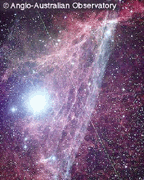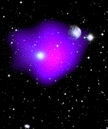Exploring at Other Wavelengths
For a long time, astronomy meant "optical" astronomy: the science of
looking at the stars and classifying them by their colors and their brightness.
The fast development of sophisticated detection techniques covering the whole
range of the electromagnetic spectrum completely transformed that science.
These days, astronomers are increasingly involved in multiwavelength studies--
making observations at energies ranging from the lowest possible (radio) to the
highest ever detected (gamma-rays).

Copyright WIYN Consortium Inc. |
It is not always possible to study an object across the whole range of
energies: The emissions of some objects are too faint to be detected, some objects are obscured and
some just don't produce any radiation at a given energy.
In fact, this is one of the key point of multiwavelength studies: The
detection of radiations at a given energy provides crucial information on the
physical conditions existing in the object because different physical phenomena
produce different signature radiation.
Sometimes, a multiwavelength analysis of an object suffices to explain its
mystery or at least clarify it.
For example, last year, scientists were analyzing X-ray images of a supernova remnant called Vela. They discovered, hidden behind it, an unknown
object. Both the image and the scant X-ray spectrum of this new object seemed
to indicate that it was another young supernova remnant, but they could not be
sure. The follow-up detection of the high energy radioactive decay
of Titanium-44 (an element usually formed during supernova explosions)
established with certainty that it was indeed a young supernova remnant.
Both the X-ray spectra and the very high energy line helped solve this
mystery. One piece of information would not have been enough.
|

X-ray Images of Vela,
taken by the ROSAT satellite | 
Optical image copyright David Malin,
AAO. |
Sometimes these astronomical mysteries are not solved completely, though they are made less puzzling, as in the study of gamma-ray bursts.
Gamma-ray bursts are flashes of very high energy light of unknown origins which
are detected coming from all the parts of the sky. In previous observations, the bursts seemed to appear and disappear randomly and none could be associated with certainty to an existing galaxy (remember that gamma-rays are hard to focus on a detector so the precise position of the bursts on the sky is very uncertain). This drastically changed when an X-ray satellite (called Beppo-Sax) succeeded in pinning down the position of one burst right after it occurred, and an
optical follow-up identified the burst dim host galaxy. Although scientists still don't know what causes gamma-ray bursts, the use of multiwavelength analysis has lifted part of the complete mystery which surrounded those objects for more than 15 years.

Above are optical and X-ray images of a cluster of galaxies superimposed over each other. The purple false-color cloud is hot gas.
|
It can also happen that the mystery only deepens as the result of new
information (a scientist's favorite scenario).
This is what happened in the study of clusters of galaxies. Optical studies of rotation curves from galaxies revealed that the bright gas
that one sees in a telescope could not account for all the matter present. Scientists started to search for the "dark matter".
X-ray observations of clusters of galaxies revealed a hot gas (at a temperature
greater than 10 of millions degrees) permeating between galaxies which are
bound together by the gravitational potential of the group. This gas is
invisible at any other energy but unfortunately it cannot account for all the
missing matter: The combined X-ray and optical data still imply the presence of
a hidden mass, sometimes 100 to 300 larger than the one observed. It is called "dark matter" because it is invisible at all energies. This problem is still a complete mystery.
There are many more examples of the potential of multiwavelength
observations. It will take more time, though, until we are able to study the
sky with the same precision at all the energies of the electromagnetic
spectrum. When this happens, we will, for the first time, be able to contemplate the universe as it really is.
|
|
